The Bucket List is a funny, heartstring-pulling movie about two terminally ill men who complete a wish list of experiences before they kick the bucket. They skydive, race classic cars, go on a safari and ride a motorcycle atop the Great Wall of China. Since the movie came out in 2007, “bucket list” has entered our lexicon, and many of us now have lists of our own. “Ride a motorcycle in the Alps” should be on that list.
Upon completing Edelweiss Bike Travel’s 6-day Alps Extreme Tour (Rider, October 2010), I wanted desperately to go back, to again ride over some of the legendary passes and to have my breath taken away by ones I had missed. The supply of smoothly paved, ridiculously curvy, majestically scenic roads in the Alps is inexhaustible. You could live your entire life in the heart of that ancient mountain range, stretching 750 glorious miles over eight countries, and never ride every great road.
It took two years of wrangling but I finally made it back, this time with my girlfriend Carrie as a passenger. After spending a few days sightseeing and acclimatizing to the time zone in Switzerland, we took a scenic train ride to Seefeld, Austria, a picturesque ski resort town tucked into the mountains above Innsbruck that serves as base camp for Edelweiss’ Touring Center Alps. Edelweiss offers Touring Centers in the Dolomites and Norway as well, and all differ from traditional tours in several ways. First, whereas most guided tours follow a circuitous route with overnight stays in different hotels almost every night, a Touring Center occupies the same hotel for the entire tour. That means you only have to unpack your stuff once, but it also means that you eat breakfast and dinner in the same hotel for a week. Second, on a traditional tour, because the group moves from hotel to hotel along the route, you have no choice but to ride. Touring Center routes start and end at the same hotel each day, allowing participants to skip a day and relax or do some sightseeing, or small groups to take entirely different routes of their choosing. Lastly, because Touring Center itineraries are Sunday to Saturday with five riding days and no chase van, they’re more affordable and manageable than longer tours.
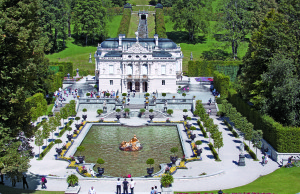
On a Sunday afternoon in mid-August, we checked into Hotel Central, the aptly named, charming, four-star hotel that was our home for a week. Owned by a former Edelweiss customer who keeps a BMW R 1150 GS and a World War II-surplus Willys jeep out back, it has comfortable, stylish rooms, spa facilities, a restaurant and bar, and even a wine cellar, where proprietor Hans Ölhafen hosted a complimentary tasting for our group. At the Welcome Briefing, we met our knowledgeable, friendly, English-speaking Austrian tour guides, Hans and Tom, as well as 20 other participants from the U.S., Canada, Australia and Brazil. Prior to the tour, Edelweiss mailed us a map of the Alps and a detailed tour book with information about the countries we’d be riding in, daily itineraries, rules and regulations, and what to pack. Most of the group had been on one or more Edelweiss tours before, but head tour guide Hans covered everything in detail, with a strong emphasis on safety. Edelweiss has been running guided tours around the world, with particular expertise in the Alps, since 1980, so they have the process dialed in. Because the tour has an intermediate difficulty rating, several riders opted for a pre-tour training ride with the guides to get a feel for alpine roads.
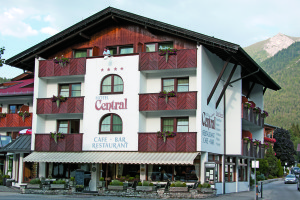
The five daily routes ranged from 125 to 225 miles, with an 8:30 a.m. departure and arrival back at the hotel by 5:00 p.m., allowing plenty of time to shower and unwind before dinner. To keep the group manageable, the 14 bikes were split between the two guides. We stopped every hour or so for coffee or to take photos at scenic locations, and lunch breaks were relaxed and inexpensive. On several days, a small group struck out on their own with a route programmed on a GPS by Hans. Edelweiss believes the experience should be whatever you want: ride with the group every day, ride on your own every day (two-bike minimum for safety), spend every day sightseeing or lounging at the hotel, or any combination thereof.
The first day’s route was on roads that weren’t especially challenging, allowing everyone to get a feel for the group and the bikes they had rented—mostly BMW GS and RT models, plus two Ducatis (Multistrada and Monster 696) and a Suzuki V-Strom 650. A wide variety of BMW, Ducati, Honda, Kawasaki and Triumph motorcycles are available to rent, even bikes you can’t buy in the U.S. like the Honda Crosstourer, and the tour price varies by up to $1,100 depending on the motorcycle that’s chosen. First-day highlights included picturesque farm roads through the Leutasch Valley, the twisties of Kesselberg, fresco paintings on houses in Oberammergau and a tour of Linderhof Palace.
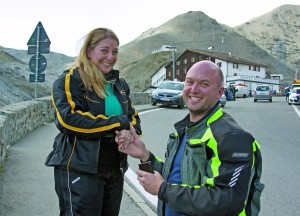
Tuesday was a big day, in more ways than one. The 225-mile route was the longest of the tour, crossing into Italy and Switzerland. Tackling Stelvio Pass (9,045 feet), the second highest paved pass in the Alps, required a challenging ride up 60 steep, tricky switchbacks through chaotic traffic—a free-for-all of cars, RVs, bicycles and motorcycles in both directions. At the top we were rewarded with stunning views of the road below and rugged mountains topped with glaciers. But I got an extra reward. After snapping a few photos from the overlook, I turned and got down on one knee, taking Carrie by surprise. Opening a ring box, I asked her to marry me. She said yes!
Stelvio Pass was certainly a highlight of the week, but the rest of the tour continued to enthrall us. Our central location in western Austria provided easy access to Switzerland to the west, Germany to the north and Italy to the south, each country having its own special wonders and mix of sights, sounds, smells, sensations and tastes. Riding up and over each pass—Jaufenpass (6,870 feet), Penserjoch (7,254 feet), Timmeljoch (8,117 feet) and Umbrail Pass (8,205 feet), among others—brought delights such as glaciers, lakes, even rainbows, and the roads, bridges and tunnels are masterpieces of civil engineering. We visited medieval towns, ate authentic local food and soaked up alpine culture. At the beginning and end of each day, everyone convened around a long table to break bread, building new friendships based on our shared experiences.
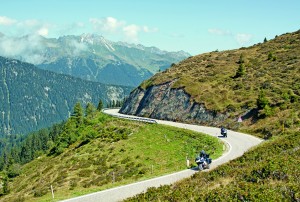
All too quickly, our week came to an end. We wanted to ride more and spend more time with our new friends. We enjoyed having our room cleaned each day, the friendly service of Hotel Central’s owners and staff (they’re quick with a refreshing beer at the end of each day!), and the variety of delicious food at each morning’s breakfast buffet and each evening’s fixed menu, which included several options, plus appetizers, salad bar and dessert. We enjoyed the company and expertise of our Austrian tour guides, who know the Alps well and understand the region’s peculiar weather patterns, where a range of temperatures and rain are common. They juggled routes based on the forecast, allowing us to avoid rain in one area while bagging epic passes in another.
The Touring Center Alps is offered four times in 2013, once in late May and three times in July and August, with prices starting at $2,580. The July and August dates are high season, requiring a $300 per person surcharge. Going in May saves money and cuts down on late-summer traffic and heat. Regardless of when you go, it will be unforgettable.
For more information, visit edelweissbike.com or call Edelweiss Bike Travel at (011) 43-5264-5690.
(This article Engaging the Senses: Edelweiss Bike Travel Touring Center Alps was published in the February 2013 issue of Rider magazine.)

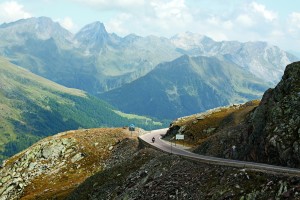
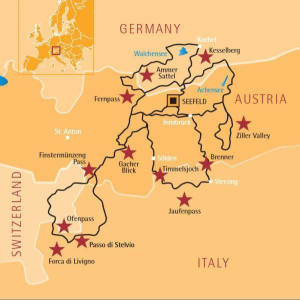
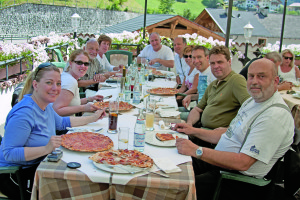
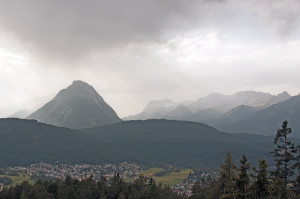
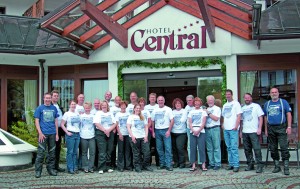
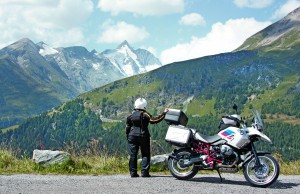
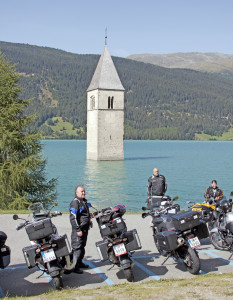







Greg: A quick comment on Graun/Curon. The village isin’t submerged by the lake; everything except the church tower was demolished before they filled the lake. The last time I was there, they had lowered the level of the lake to do repairs on the tower, which was on “dry land”, and you could see that there was nothing else there. The tower was preserved at the request of the archeology department at the University of Milan, because of it’s age; 12-13th century. As it happens, I was on the first “Alps Extreme” tour, which was led by Werner himself.
Thanks for your comments, James. All of the references I have found indicate that 163 homes were submerged after the dam was built and the rising waters unified the two smaller lakes (Reschensee and Mittersee), and that the church dates to the 14th century, not the 12th or 13th centuries. If you have reference for the village being demolished before the dam was completed, please share it.
Having done both the Alps Extreme and Touring Center Alps tours, I’ve been to Graun (and Passo di Stelvio) twice, and was thoroughly delighted both times. What a wonderful part of the world to experience on two wheels!
–Greg Drevenstedt
Well, better late than never. The best sites on the subject are Obervinshgau.it, and the article “The Reschensee and how it came about” and “Graun at Reschense July 1950, Farewell to grays”, both of which describe the destruction of the town, and have multiple photos. (Including the town in the process of being reduced to rubble, and the “barracks” that the townspeople were relocated to). Also, search “Rescansee” photos, and you’ll see pics of the tower on dry land, as it was when I saw it in 2008. In these articles, they say that the church tower dates to 1314. The better story is that they tried to blow up the tower, but after the third unsuccessful attempt, the decided that God didn’t want it to be destroyed. Given the extent of the renovations that I saw, I’d opt for the architectural significance explanation.
It’s really a sad story, especially when you see what the town(s) looked like, and it really is goverment hubris at it worst.
Also, the Swiss were going to build a dam which would have drowned the town of Splugen, but there was a huge outcry, so they looked around and saw the plans for Graun/Curon, which the Italians couldn’t build because they had no money in the years after WWII. The Swiss made a deal: they would give Italy the money for the dam construction, in exchange for which they would get all the power generated for the first ten years, which is how they were able to build the dam.. The photos in “images” show the tower in 2008, encased in scaffolding, but as you can see, there are no other buildings around. I know that the 3D “map” of the village in the pavilion at Curon shows the village “underwater”, but I can assure you; there’s nothing left but the tower.
Also, search “Lago di Lei” and look at the ADVRiders ride report, then look at the map of the border. there’s a rectangle of Swiss territory jutting into Italy, because the Swiss would only build the dam if they owned the terrriory on which it was built, hence the “incursion” into Italy. If you keep going up the road, you reach Juf, the highest continously inhabited village in Europe.
Also, look up “Lost Places Graun am Reschensee”; you will see photos showing the gradual destruction of the town, starting with removing the roofs, then knocking down the houses until there were just piles of rubble, and even that was carted away. If you look at the “before” photos, you’ll see that the roof of the church next to the steeple was almost as high, so if it were still there, you’d see that as well. Again, the best views are on Google “images”, where you’ll see the steeple “on dry land”; there is a levee behind the church, and they blocked that off and pumped it out to do the extensive repair work.
Also, if you go to the “new” town of Graun (relocated higher up the hill), you’ll see that they build a new church, with a steeple that’s almost a dead ringer for the one in the lake. And by the way, the people of the town received no compensation for the “taking”.